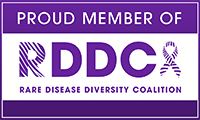![]()
What is the Genome Research in African-American Scleroderma Patients (GRASP) Project?
GRASP is a genomics project that aims to broaden our understanding of scleroderma and enable more effective care for African Americans affected by this condition. It was created to better understand, from a genetic standpoint, why African Americans seem to be affected by scleroderma more frequently and with greater severity than patients of European-ancestry.
Research is the key to finding new treatments for scleroderma. Thanks to the collaboration of patients, clinicians and researchers, GRASP’s comprehensive database is already enabling important analyses which may lead to earlier detection and treatment of the disease. While the differences in disease onset and severity in African American scleroderma patients can only be understood by studying African American patients, the discoveries made from understanding the genetics of scleroderma in African Americans will benefit patients of all ethnic backgrounds.
To date, the GRASP project attempts to elucidate the factors influencing increased disease incidence, prevalence, and severity have been hindered by the relatively small size of studied African American scleroderma cohorts.
Why is the GRASP Project Important?
Previous epidemiological studies have indicated that African Americans are more likely to get scleroderma than Americans of European ancestry; they also tend to have an earlier age of onset of scleroderma and more severe disease.
Data collected from the GRASP Project will allow researchers to develop a better understanding of how scleroderma typically presents in African American patients, and ultimately will aid physicians in treating scleroderma African American patients as well as all scleroderma patients. The Scleroderma Research Foundation has been involved in the development and funding of this important project since the very beginning, when the idea to develop a multi-center study was envisioned by Drs. Fred Wigley and Dan Kastner at the annual SRF Science Workshop.
The Goals of the Grasp Project
A primary goal of the GRASP Project has been to obtain clinical data from a sufficiently large population of African American patients for researchers to better understand scleroderma in African American patients. Using the GRASP clinical data, researchers will confirm or disprove the observations about increased incidence, age of onset and disease severity and to develop a better understanding of how scleroderma typically presents in African American patients.
Another goal of the GRASP Project is to generate a large set of genomic data, through DNA sequencing of scleroderma patient samples and control patient samples from other studies, that can be compared and used to determine whether specific scleroderma clinical manifestations correlate with specific DNA variants. Through these associations, researchers hope to learn about DNA variants that might affect scleroderma susceptibility, age of onset, and disease severity.
PATIENT FORUM
Advancing Genomic Research
Research advances like the GRASP Project are the result of innovative thinking and a collaborative approach – key to finding new treatments for scleroderma. Learn more about GRASP and other types of genomic research in the SRF’s Inaugural Patient Forum video.
How Does It Work?
In order to achieve these goals, consortium members enrolled a large cohort of African American scleroderma patients. They collected data and DNA samples as part of this process. More than 1,350 African American scleroderma patients, enrolled from 26 participating U.S. academic centers, participated in the GRASP Project. This is the largest multicenter cohort of African American scleroderma patients ever studied.
Insights from a GRASP Participant
Lovette R. participated in the GRASP research project. “When people are inquisitive, it helps to advance the understanding of what scleroderma is and finding a cure,” she says. “I want to offer myself and my situation as much as I can to help find a cure.”

What Are the Results of GRASP So Far?
GRASP’s comprehensive clinical database and its significant size are already enabling important analyses. These have included a careful characterization of the relevant clinical features and the analysis of the specific repertoire of autoantibodies presented by African American patients.
The investigators of GRASP are confident that the discoveries prompted by this project will have a major impact also for patients of other ethnic backgrounds. Genomic variants critical for the development of scleroderma and its specific disease manifestations could be shared across different ethnicities or subsets of patients with worse disease outcomes. This will help researchers decipher the fundamental biological processes that cause scleroderma and its progression with greater precision.
The analysis of the GRASP data has confirmed the unique and severe disease burden of scleroderma in African Americans. It also highlights key factors associated with clinically relevant disease outcomes.
For example, the incidence of severe scleroderma-associated interstitial lung disease (SSc-ILD) and pulmonary arterial hypertension (PAH) was confirmed to be higher in this ethnic group compared to others. Socioeconomic factors and impaired access to health care do not fully account for the predilection of African American scleroderma patients to poor clinical outcomes. (See Morgan, et. al. Medicine, 2017.)
And, GRASP investigators have found unique African ancestry-derived genetic variants increase the risk of scleroderma and various SSc-related complications in the studied African American population. (See Gourh, et. al., Arthritis Rheumatol., 2017; Gourh, et. al., PNAS, 2020.)
The GRASP Consortium Institutions
Boston University • Cedars Sinai Medical Center • Columbia University • Emory University • Georgetown University • George Washington University• Henry Ford Health System • Hospital for Special Surgery • Johns Hopkins University • Medical University of South Carolina • New York University • NIH • Northwestern University Rutgers University • Stanford University • Tulane University • University of Alabama–Birmingham • UCLA • UCSF • University of Chicago • University of Cincinnati • University of Michigan • University of Pennsylvania University of Pittsburgh • University of Rochester • University of Texas-Houston • Yale University
Project Leadership
Financial support for the GRASP Project is provided by the National Human Genome Research Insititute (NHGRI) and the Scleroderma Research Foundation (SRF), America’s largest nonprofit investor in scleroderma research.
Project Leads

Fredrick Wigley, MD
Johns Hopkins University School of Medicine


Francesco Boin, MD
Cedars-Sinai Medical Center

In Collaboration With:

Dan Kastner, MD, PhD
National Human Genome Research Institute (NHGRI)


Charles Rotimi, PhD
National Human Genome Research Institute (NHGRI)


Pravitt Gourh, MD
National Institutes of Arthritis and Musculoskeletal Diseases (NIAMS)

OUR RESEARCH
Dive Deeper into Our Research
Dig into the details of our research program to understand more about the science behind what our elite researchers are doing to find better treatments and, ultimately, a cure.

